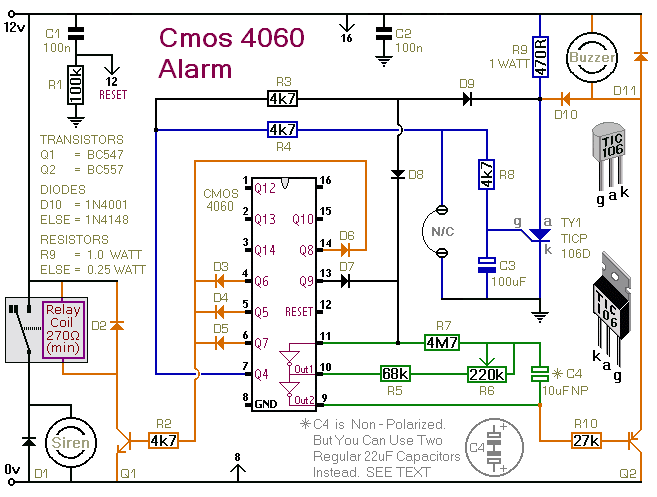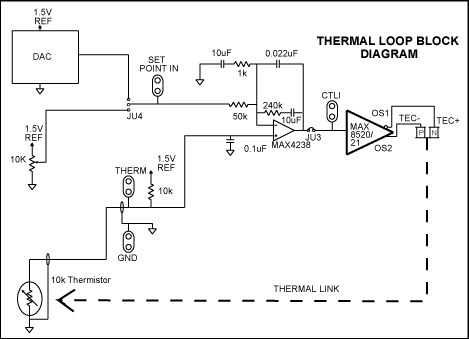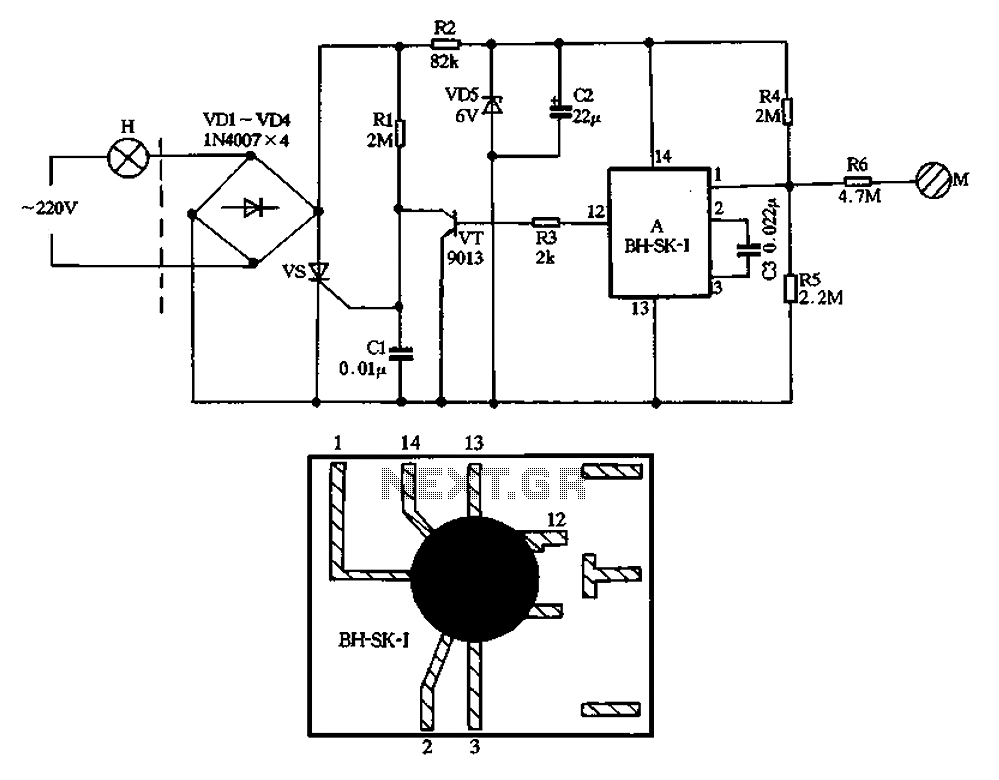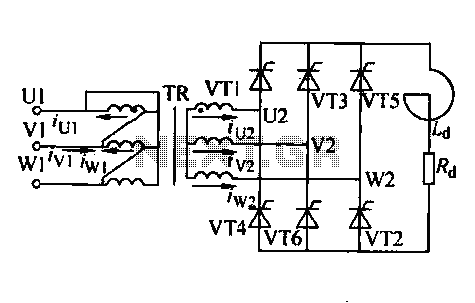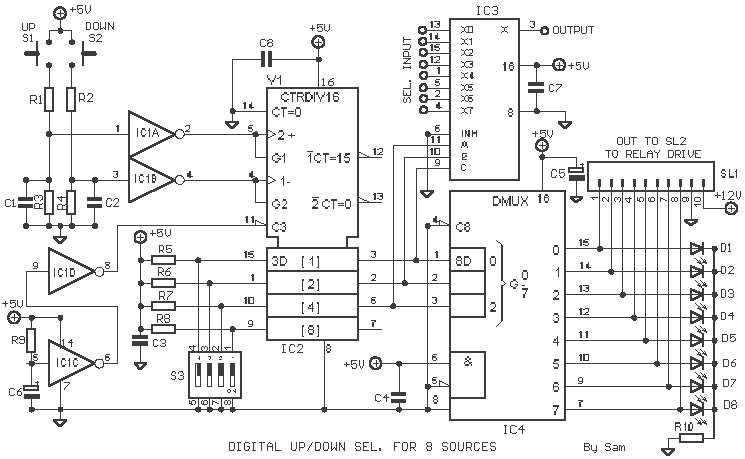
Discrete components sound and light control stairs delay switch circuit 5
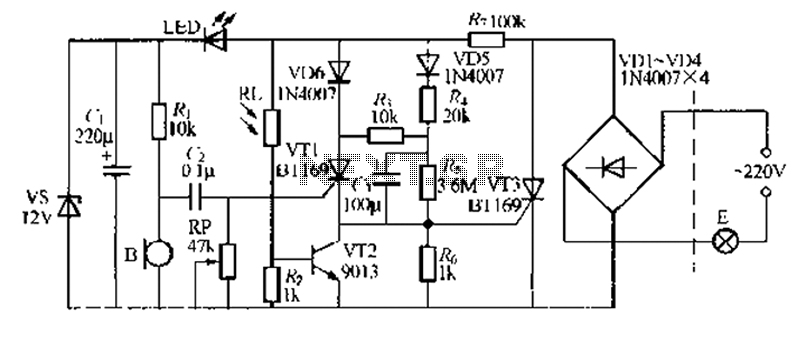
A relatively simple circuit for controlling a stair walkway light with a delay feature. The circuit has a drawback in that the voice activation is somewhat less sensitive, making it sometimes difficult to trigger with general conversation. However, it can be activated by clapping or directly tapping the switch or light panel. The circuit comprises a photosensitive resistor (R1), a resistor (R), and a transistor (VT2) that manage the light control. When R1 shows low resistance, VT2 conducts, keeping VT3 at a low level, which prevents the lamp (E) from shining. During this state, the voltage across certain components is maintained, and when the resistance of R1 increases, VT2 turns off, allowing VT3 to activate the light. The circuit responds to sound signals, which can trigger VT1 to turn on the light. A capacitor (C) helps maintain the state of VT1 after the sound ceases, and the circuit will eventually turn off the light when the voltage drops below a certain threshold. The design includes a trim resistor (R1) to adjust the sensitivity of the voice activation feature.
The circuit operates using a combination of photoresistive and acoustic sensing elements to control the lighting system effectively. The photosensitive resistor (R1) detects ambient light levels, influencing the operation of the transistors (VT2 and VT3). When the ambient light is low, R1 exhibits low resistance, allowing VT2 to conduct and keeping VT3 in a non-conductive state, thus preventing the lamp (E) from illuminating. Conversely, when ambient light increases, R1's resistance rises, leading to the deactivation of VT2, which enables VT3 to power the lamp.
The acoustic detection mechanism is facilitated by the transistor VT1, which is triggered by sound waves, such as clapping. This sound is coupled to VT1, activating it and allowing current to flow, which energizes the circuit and turns on the lamp. The capacitor (C) plays a crucial role in maintaining the conduction state of VT1 momentarily after the sound has ceased. This feature ensures that the light remains on for a brief delay, enhancing user convenience.
The design includes a trim resistor (R) that allows for the adjustment of the sensitivity of the voice activation feature. By modifying the resistance, the user can either increase or decrease the sensitivity, tailoring the circuit's responsiveness to ambient noise levels. This adjustment is particularly useful in environments with varying noise conditions.
In summary, the circuit provides a practical solution for stairway lighting with both light and sound activation features. It combines photoresistive and acoustic sensing technologies, offering flexibility in sensitivity adjustment and ensuring reliable operation in various lighting and sound conditions.A relatively simple circuit Lu Qing, stair walkway light control delay light switch, the disadvantage voice a little less sensitive, and sometimes difficult general conversatio n Lu canthus trigger, but you can beat the sound of shoulder F switch or direct slap open close open panel beam light. Photosensitive resistance Rl., R, and the composition of VT2 light control lb Road, H days, RI. Showed a low resistance, VT2 conduction, VT3 door is clamped at a low level, VT3 off, lamp E does not shine.
At this time (jl by VDa, marrow grams electrically to 13 (iV about (vs LED light tube voltage value plus positive l sentence drop) evening RI. Showed a high resistance, VT Off, VT3 lifting of the blockade, but because R ,. i far Ding R, VT3 is still in the off state, the light is still on, when someone from the sound of speech or clap clap, Ij pick up acoustic signals through (coupled, direct-cho trigger VT1 open.
Sh, then 1: ~. power by about 6V iF VD6, VT1 VT3 f J Feng people pole, so VT3 trigger the opening of electric powered lights E-emitting. VT1 lose after the sound f J pole} U flow, but the mountains in C, stored charge through R. to put VT1 in, make VT1 work under sunny Xi iu claw stop, so VT1 still maintain open state (j. Hui: discharge at the same time, but also by VDj, R, full-wave pulsating DC charging but R; a big R, Therefore (1 voltage across gradually drop, Sheng finally unable to maintain VT1 conduction.
seasonal ferry pulsating DC zero crossing, VT1 off. In this case C. continue VDo, R, and VT3 gate charge, the charging current can be maintained VT3 conduction state remains until full charge to f, V [3 seeker trigger current when the AC zero crossing that is shut off, turn off the lamp E. arc tube I.EI) in this collapse was two: one foot at night emitting low light, indicating the switch position bone; the second is isolated from the action, so that the anode and VT3 VT] usually work in the whole gate crossing the pulsating DC voltage conditions F.
trim resistor. RI side of town for the festival circuit voice sensitivity increase Save resistor R. the resistance can be adjusted from the control light control circuit point; after this circuit is energized, if not out long bright lights F can be increased R. (or decrease wind) adjustment.
The circuit operates using a combination of photoresistive and acoustic sensing elements to control the lighting system effectively. The photosensitive resistor (R1) detects ambient light levels, influencing the operation of the transistors (VT2 and VT3). When the ambient light is low, R1 exhibits low resistance, allowing VT2 to conduct and keeping VT3 in a non-conductive state, thus preventing the lamp (E) from illuminating. Conversely, when ambient light increases, R1's resistance rises, leading to the deactivation of VT2, which enables VT3 to power the lamp.
The acoustic detection mechanism is facilitated by the transistor VT1, which is triggered by sound waves, such as clapping. This sound is coupled to VT1, activating it and allowing current to flow, which energizes the circuit and turns on the lamp. The capacitor (C) plays a crucial role in maintaining the conduction state of VT1 momentarily after the sound has ceased. This feature ensures that the light remains on for a brief delay, enhancing user convenience.
The design includes a trim resistor (R) that allows for the adjustment of the sensitivity of the voice activation feature. By modifying the resistance, the user can either increase or decrease the sensitivity, tailoring the circuit's responsiveness to ambient noise levels. This adjustment is particularly useful in environments with varying noise conditions.
In summary, the circuit provides a practical solution for stairway lighting with both light and sound activation features. It combines photoresistive and acoustic sensing technologies, offering flexibility in sensitivity adjustment and ensuring reliable operation in various lighting and sound conditions.A relatively simple circuit Lu Qing, stair walkway light control delay light switch, the disadvantage voice a little less sensitive, and sometimes difficult general conversatio n Lu canthus trigger, but you can beat the sound of shoulder F switch or direct slap open close open panel beam light. Photosensitive resistance Rl., R, and the composition of VT2 light control lb Road, H days, RI. Showed a low resistance, VT2 conduction, VT3 door is clamped at a low level, VT3 off, lamp E does not shine.
At this time (jl by VDa, marrow grams electrically to 13 (iV about (vs LED light tube voltage value plus positive l sentence drop) evening RI. Showed a high resistance, VT Off, VT3 lifting of the blockade, but because R ,. i far Ding R, VT3 is still in the off state, the light is still on, when someone from the sound of speech or clap clap, Ij pick up acoustic signals through (coupled, direct-cho trigger VT1 open.
Sh, then 1: ~. power by about 6V iF VD6, VT1 VT3 f J Feng people pole, so VT3 trigger the opening of electric powered lights E-emitting. VT1 lose after the sound f J pole} U flow, but the mountains in C, stored charge through R. to put VT1 in, make VT1 work under sunny Xi iu claw stop, so VT1 still maintain open state (j. Hui: discharge at the same time, but also by VDj, R, full-wave pulsating DC charging but R; a big R, Therefore (1 voltage across gradually drop, Sheng finally unable to maintain VT1 conduction.
seasonal ferry pulsating DC zero crossing, VT1 off. In this case C. continue VDo, R, and VT3 gate charge, the charging current can be maintained VT3 conduction state remains until full charge to f, V [3 seeker trigger current when the AC zero crossing that is shut off, turn off the lamp E. arc tube I.EI) in this collapse was two: one foot at night emitting low light, indicating the switch position bone; the second is isolated from the action, so that the anode and VT3 VT] usually work in the whole gate crossing the pulsating DC voltage conditions F.
trim resistor. RI side of town for the festival circuit voice sensitivity increase Save resistor R. the resistance can be adjusted from the control light control circuit point; after this circuit is energized, if not out long bright lights F can be increased R. (or decrease wind) adjustment.
Warning: include(partials/cookie-banner.php): Failed to open stream: Permission denied in /var/www/html/nextgr/view-circuit.php on line 713
Warning: include(): Failed opening 'partials/cookie-banner.php' for inclusion (include_path='.:/usr/share/php') in /var/www/html/nextgr/view-circuit.php on line 713
